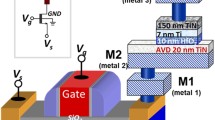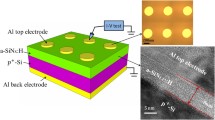Abstract
Resistive switching random access memory (RRAM) is one of the most promising candidates with high-density three-dimensional integration characteristics for next-generation nonvolatile memory technology. However, the poor uniformity issue caused by the stochastic property of the conductive filament (CF) impedes the large-scale manufacture of RRAM chips. Subulate array has been introduced into the RRAM to minimize the CF randomness, but the methods are cumbersome, expensive, or resolution-limited for large-scale preparation. In this work, Si subulate array (SSA) substrates with different curvature radii prepared by a wafer-scale and nanoscale-controllable method are introduced for RRAM fabrication. The SSA structure, which induces a quasi-single CF or a few CFs formed in the tip region (TR) of the device as evidenced by the high-resolution transmission electron microscopy and energy dispersive spectroscopy characterization, dramatically improves the cycle-to-cycle and device-to-device uniformity. Decreasing the curvature radius of the TR significantly improves the device performance, including switching voltages, high/low resistance states, and retention characteristics. The improved uniformity can be attributed to the enhanced local electric field in the TR. The proposed SSA provides a low-cost, uniform, CMOS-compatible, and nanoscale-controllable optimization strategy for the large-scale integration of highly uniform RRAM devices.
摘要
具有高密度三维集成特点的阻变存储器(RRAM)是下一代非易失性存储技术的有利竞争者之一. 然而, 导电细丝形成和断裂的随机性导致了RRAM均一性差的问题, 这严重阻碍了RRAM芯片的大规模商用. 目前, 已有部分研究通过引入锥形结构, 减少RRAM中导电细丝形成和断裂的随机性. 但是, 这些方法往往步骤繁琐、 成本较高或分辨率有限, 限制了这些技术的大规模推广. 本研究提出了一种CMOS兼容的、 可在纳米尺度调控的晶圆级硅锥阵列(SSA)制备方法. 该方法可制备不同曲率半径的SSA, 用于调控RRAM中的导电细丝. 高分辨率透射电子显微镜和能量色散谱表征结果表明, SSA结构诱导器件在尖端区域形成准单根或少量的导电细丝, 显著改善了器件转变参数的均一性. 此外, 减小尖端区域的曲率半径可显著提升器件转变电压和高/低阻态的分布均一性及器件阻态的保持特性等. 器件转变参数均一性的改善归因于尖端区域内的局域电场增强效应. 本研究所提出的SSA方法具备低成本、 CMOS兼容且纳米尺度可控的特点, 为高均一性RRAM器件的大规模集成提供了一种参考策略.
Similar content being viewed by others
References
Meijer GI. Who wins the nonvolatile memory race? Science, 2008, 319: 1625–1626
Li Y, Long S, Liu Q, et al. Resistive switching performance improvement via modulating nanoscale conductive filament, involving the application of two-dimensional layered materials. Small, 2017, 13: 1604306
Hui F, Grustan-Gutierrez E, Long S, et al. Graphene and related materials for resistive random access memories. Adv Electron Mater, 2017, 3: 1600195
Waser R, Aono M. Nanoionics-based resistive switching memories. Nat Mater, 2007, 6: 833–840
Kim KH, Gaba S, Wheeler D, et al. A functional hybrid memristor crossbar-array/CMOS system for data storage and neuromorphic applications. Nano Lett, 2012, 12: 389–395
Nagashima K, Yanagida T, Oka K, et al. Intrinsic mechanisms of memristive switching. Nano Lett, 2011, 11: 2114–2118
Waser R, Dittmann R, Staikov G, et al. Redox-based resistive switching memories-nanoionic mechanisms, prospects, and challenges. Adv Mater, 2009, 21: 2632–2663
Kwon DH, Kim KM, Jang JH, et al. Atomic structure of conducting nanofilaments in TiO2 resistive switching memory. Nat Nanotech, 2010, 5: 148–153
Yang JJ, Pickett MD, Li X, et al. Memristive switching mechanism for metal/oxide/metal nanodevices. Nat Nanotech, 2008, 3: 429–433
Janousch M, Meijer G, Staub U, et al. Role of oxygen vacancies in Crdoped SrTiO3 for resistance-change memory. Adv Mater, 2007, 19: 2232–2235
Guan X, Yu S, Wong HSP. On the switching parameter variation of metal-oxide RRAM—Part I: Physical modeling and simulation methodology. IEEE Trans Electron Devices, 2012, 59: 1172–1182
Luo WC, Liu JC, Lin YC, et al. Statistical model and rapid prediction of RRAM SET speed-disturb dilemma. IEEE Trans Electron Devices, 2013, 60: 3760–3766
Wang G, Long S, Yu Z, et al. Improving resistance uniformity and endurance of resistive switching memory by accurately controlling the stress time of pulse program operation. Appl Phys Lett, 2015, 106: 092103
Long S, Perniola L, Cagli C, et al. Voltage and power-controlled regimes in the progressive unipolar reset transition of HfO2-based RRAM. Sci Rep, 2013, 3: 2929
Long S, Lian X, Ye T, et al. Cycle-to-cycle intrinsic reset statistics in HfO2-based unipolar RRAM devices. IEEE Electron Device Lett, 2013, 34: 623–625
Wong HSP, Lee HY, Yu S, et al. Metal-oxide RRAM. Proc IEEE, 2012, 100: 1951–1970
Yang JJ, Strukov DB, Stewart DR. Memristive devices for computing. Nat Nanotech, 2013, 8: 13–24
Yoon JH, Han JH, Jung JS, et al. Highly improved uniformity in the resistive switching parameters of TiO2 thin films by inserting Ru nanodots. Adv Mater, 2013, 25: 1987–1992
Chen L, Gou HY, Sun QQ, et al. Enhancement of resistive switching characteristics in Al2O3-based RRAM with embedded ruthenium nanocrystals. IEEE Electron Device Lett, 2011, 32: 794–796
Guan W, Long S, Jia R, et al. Nonvolatile resistive switching memory utilizing gold nanocrystals embedded in zirconium oxide. Appl Phys Lett, 2007, 91: 062111
Ryu SW, Ahn YB, Kim HJ, et al. Ti-electrode effects of NiO based resistive switching memory with Ni insertion layer. Appl Phys Lett, 2012, 100: 133502
Lin CY, Lin MH, Wu MC, et al. Improvement of resistive switching characteristics in SrZrO3 thin films with embedded Cr layer. IEEE Electron Device Lett, 2008, 29: 1108–1111
Lv H, Wan H, Tang T. Improvement of resistive switching uniformity by introducing a thin GST interface layer. IEEE Electron Device Lett, 2010, 31: 978–980
Zhang H, Liu L, Gao B, et al. Gd-doping effect on performance of HfO2 based resistive switching memory devices using implantation approach. Appl Phys Lett, 2011, 98: 042105
Yoon J, Choi H, Lee D, et al. Excellent switching uniformity of Cudoped MoOx/GdOx bilayer for nonvolatile memory applications. IEEE Electron Device Lett, 2009, 30: 457–459
Zhao X, Ma J, Xiao X, et al. Breaking the current-retention dilemma in cation-based resistive switching devices utilizing graphene with controlled defects. Adv Mater, 2018, 30: 1705193
Zhao X, Liu S, Niu J, et al. Confining cation injection to enhance CBRAM performance by nanopore graphene layer. Small, 2017, 13: 1603948
Shin KY, Kim Y, Antolinez FV, et al. Controllable formation of nanofilaments in resistive memories via tip-enhanced electric fields. Adv Electron Mater, 2016, 2: 1600233
Kim Y, Choi H, Park HS, et al. Reliable multistate data storage with low power consumption by selective oxidation of pyramid-structured resistive memory. ACS Appl Mater Interfaces, 2017, 9: 38643–38650
Kim S, Jung S, Kim MH, et al. Nano-cone resistive memory for ultralow power operation. Nanotechnology, 2017, 28: 125207
Coluccio ML, Francardi M, Gentile F, et al. Plasmonic 3D-structures based on silver decorated nanotips for biological sensing. Opt Laser Eng, 2016, 76: 45–51
Li X, Zhang B, Wang B, et al. Low power and high uniformity of HfOx-based RRAM via tip-enhanced electric fields. Sci China Inf Sci, 2019, 62: 202401
Li W, Song X, Zhao X, et al. Design of wafer-scale uniform Au nanotip array by ion irradiation for enhanced single conductive filament resistive switching. Nano Energy, 2020, 67: 104213
Kim HJ, Yoon KJ, Park TH, et al. Filament shape dependent reset behavior governed by the interplay between the electric field and thermal effects in the Pt/TiO2/Cu electrochemical metallization device. Adv Electron Mater, 2017, 3: 1600404
Celano U, Goux L, Belmonte A, et al. Understanding the dual nature of the filament dissolution in conductive bridging devices. J Phys Chem Lett, 2015, 6: 1919–1924
Celano U, Giammaria G, Goux L, et al. Nanoscopic structural rearrangements of the Cu-filament in conductive-bridge memories. Nanoscale, 2016, 8: 13915–13923
Berco D, Tseng TY. A numerical study of multi filament formation in metal-ion based CBRAM. AIP Adv, 2016, 6: 025212
Villena MA, Roldán JB, Jimenez-Molinos F, et al. A comprehensive analysis on progressive reset transitions in RRAMs. J Phys D-Appl Phys, 2014, 47: 205102
Jo SH, Lu W. CMOS compatible nanoscale nonvolatile resistance switching memory. Nano Lett, 2008, 8: 392–397
Chen JY, Huang CW, Chiu CH, et al. Switching kinetic of VCM-based memristor: Evolution and positioning of nanofilament. Adv Mater, 2015, 27: 5028–5033
Yang Y, Gao P, Li L, et al. Electrochemical dynamics of nanoscale metallic inclusions in dielectrics. Nat Commun, 2014, 5: 4232
Liu Q, Sun J, Lv H, et al. Real-time observation on dynamic growth/dissolution of conductive filaments in oxide-electrolyte-based ReRAM. Adv Mater, 2012, 24: 1844–1849
Choi SJ, Park GS, Kim KH, et al. In situ observation of voltage-induced multilevel resistive switching in solid electrolyte memory. Adv Mater, 2011, 23: 3272–3277
Zhang Z, Zhao Y, Zhu M. NiO films consisting of vertically aligned cone-shaped NiO rods. Appl Phys Lett, 2006, 88: 033101
Chang WY, Lin CA, He-Hau J, et al. Resistive switching behaviors of ZnO nanorod layers. Appl Phys Lett, 2010, 96: 242109
Zhu YW, Zhang HZ, Sun XC, et al. Efficient field emission from ZnO nanoneedle arrays. Appl Phys Lett, 2003, 83: 144–146
Spindt CA, Brodie I, Humphrey L, et al. Physical properties of thin-film field emission cathodes with molybdenum cones. J Appl Phys, 1976, 47: 5248–5263
Huang YC, Tsai WL, Chou CH, et al. High-performance programmable metallization cell memory with the pyramid-structured electrode. IEEE Electron Device Lett, 2013, 34: 1244–1246
Acknowledgements
This work was supported by the National Natural Science Foundation of China (61925110, 61821091, 51961145110, 62004184, and 62004186), the Ministry of Science and Technology of China (2016YFA0201803, 2016YFA0203800, and 2017YFB0405603), the Key Research Program of Frontier Sciences of Chinese Academy of Sciences (QYZDY-SSW-JSC001 and QYZDB-SSW-JSC048), the Fundamental Research Funds for the Central Universities (WK2100000014 and WK2100000010), China Postdoctoral Science Foundation (2020M671895 and BX20200320), and the Opening Project of Key Laboratory of Microelectronic Devices & Integration Technology, Institute of Microelectronics, Chinese Academy of Sciences. This work was partially carried out at the Center for Micro and Nanoscale Research and Fabrication, University of Science and Technology of China.
Author information
Authors and Affiliations
Contributions
Author contributions Zhao X and Long S designed the project and guided the research. Zhang Y, Zhang M, and Liu Y fabricated the samples and performed the electrical switching experiments. Ma X and Zhou X simulated the electrical field distribution. Xu G assisted in the data analysis. Zhang Y and Zhao X wrote and revised the paper. All authors contributed to extensive discussions of the results.
Corresponding author
Ethics declarations
Conflict of interest The authors declare that they have no conflict of interest.
Additional information
Supplementary information Supporting data are available in the online version of the paper.
Ying Zhang is currently a doctoral student at the Institute of Microelectronics, Chinese Academy of Sciences. She received her bachelor’s degree from the University of Science and Technology Beijing in 2018. Her current research focuses on the resistive random access memory.
Xiaolong Zhao is currently a postdoctor at the University of Science and Technology of China, Hefei. He received his PhD degree from Wuhan University in 2019. His current research interest mainly focuses on photodetectors based on wide-bandgap materials, novel in-sensor computing devices, and resistive random access memory.
Rights and permissions
About this article
Cite this article
Zhang, Y., Zhao, X., Ma, X. et al. CMOS-compatible wafer-scale Si subulate array for superb switching uniformity of RRAM with localized nanofilaments. Sci. China Mater. 65, 1623–1630 (2022). https://doi.org/10.1007/s40843-021-1956-9
Received:
Accepted:
Published:
Issue Date:
DOI: https://doi.org/10.1007/s40843-021-1956-9




